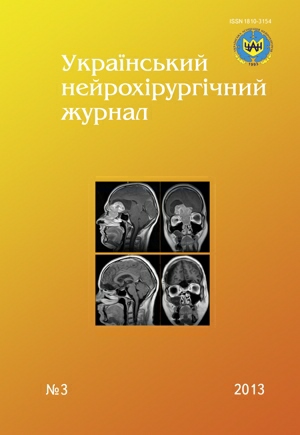Characteristics of compensatory-adaptive mechanisms depending on meningoencephalitis severity
DOI:
https://doi.org/10.25305/unj.54152Keywords:
meningoencephalitis, autonomic nervous systemAbstract
Purpose: to study compensatory-adaptive mechanisms according to cardiointervalography data depending on meningoencephalitis severity.
Materials and methods. We studied the state of autonomic nervous system and compensatory-adaptive mechanisms in patients with acute meningoencephalitis. Cardiointervalography according to R.M. Baevsky method using apparatus UTAS (Ukraine) was applied.
Results. The essential tension of compensatory-adaptive mechanisms at moderate and severe meningoencephalitis was revealed, which is a valid measure of the pathological process severity.
Conclusions. Cardiointervalographic indexes are an objective criterion of autonomic disorders severity from compensation to decompensation and pathological process severity at meningoencephalitis. To determine patient’s state severity at meningoencephalitis it’s appropriate to estimate vegetative homeostasis, ways of central stimulus implementation, state of adaptation mechanisms.References
1. Skytsyuk AS. Meninhity i meninhoentsefality u klinitsi infektsiynykh khvorob: diahnostychne ta prohnostychne znachennya providnykh klinichnykh symptomiv [Meningitis and meningoencephalitis in the clinic of infectious diseases: diagnostic and prognostic value of clinical symptoms leading] [dissertation]. Kiev (Ukraine): Gromashevsky Institute of Epidemiology and Infectious Diseases; 2012. Ukrainin.
2. Tsynzerlynh VA, Chukhlovyna ML. Infektsyonnye porazhenyya nervnoy systemy: voprosy etyolohyy, patoheneza y dyahnostyky: rukovodstvo dlya vrachey mnohoprofylnykh statsyonarov [Infection of the nervous system: etiology, pathogenesis and diagnosis: a guide for doctors multidisciplinary hospitals]. Sankt-Peterburg: Elby-SPb; 2005. Russian.
3. Polushin YuS, editor. Anesteziologiya i reanimatologiya: rukovodstvo [Anesthesiology and Intensive Care: The Guide]. Sankt-Peterburg: Elby-SPb; 2004. Russian.
4. Yakhno NN, Shtul'man DR, editors. Bolezni nervnoy sistemy: rukovodstvo dlya vrachey: v 2 t. [Diseases of the nervous system: guidelines for physicians in 2 volumes]. Moscow: Meditsina; 2001;1. Russian.
5. Popova LM. Neyroreanimatologiya [Neyroreanimatology]. Moscow: Meditsina; 1983. Russian.
6. Anokhin PK. Ocherki po fiziologii funktsional'nykh system [Essays on the physiology of functional systems]. Moscow: Meditsina; 1975. Russian.
7. Veyn AM, Kulikova YeA, Voznesenskaya TG, Golubev VL. Zabolevaniya vegetativnoy nervnoy sistemy [Diseases of the autonomic nervous system]. Moscow: Meditsina; 1991. Russian.
8. Garkavi LKh. Antistressornyye reaktsii i aktivatsionnaya terapiya [Antistress reactions and activation therapy]. Moscow: Imedis; 1998. Russian.
9. Shanin VYu. Patofiziologiya kriticheskikh sostoyaniy [Pathophysiology of critical states]. Sankt-Peterburg: Elby-SPb; 2003. Russian.
10. Bayevskiy RM. Prognozirovaniye sostoyaniy na grani normy i patologii [Prediction of states on the verge of norm and pathology]. Moscow: Meditsina; 1979. Russian.
11. Bayevskiy RM, Kirilov OI, Kletskin SZ. Matematicheskiy analiz serdechnogo ritma pri stresse [Mathematical analysis of heart rate during stress]. Moscow: Nauka; 1984. Russian.
Downloads
Published
How to Cite
Issue
Section
License
Copyright (c) 2013 Viktor Matyash, Natalia Raletc, Elena Panasyuk

This work is licensed under a Creative Commons Attribution 4.0 International License.
Ukrainian Neurosurgical Journal abides by the CREATIVE COMMONS copyright rights and permissions for open access journals.
Authors, who are published in this Journal, agree to the following conditions:
1. The authors reserve the right to authorship of the work and pass the first publication right of this work to the Journal under the terms of Creative Commons Attribution License, which allows others to freely distribute the published research with the obligatory reference to the authors of the original work and the first publication of the work in this Journal.
2. The authors have the right to conclude separate supplement agreements that relate to non-exclusive work distribution in the form of which it has been published by the Journal (for example, to upload the work to the online storage of the Journal or publish it as part of a monograph), provided that the reference to the first publication of the work in this Journal is included.









